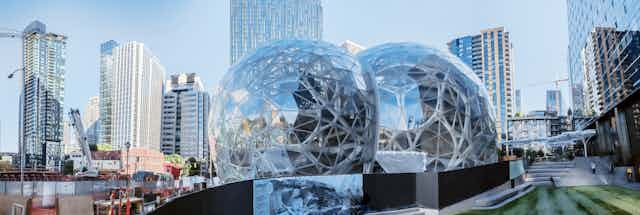Cities across the US are locked in fierce competition to host Amazon’s second headquarters – known as HQ2. This is a big race: a shortlist of 20 cities seems to think this particular corporate investment can go a long way to solving some of their ongoing economic problems.
The process of inward investment – whereby large firms establish operations in a new location, either at home or abroad – has been seen for a long time as a way of creating positive economic change. They can create many new jobs in areas which are crying out for them, but they also bring new entrepreneurial activity, improved management skills, international know-how and a wider boost to other local businesses.
But these decisions can cause big problems. As is typical, Amazon has effectively set off a competition between a number of major US cities for its investment, which means they will all now be trying to outbid each other in terms of the “offer” they can make. This will include their existing assets such as land, infrastructure, transport connectivity and, most importantly, people – ideally with the right blend of skills and aptitudes that Amazon needs.
The big downside of this form of competition is that cities will start offering inducements of a fiscal nature – usually in the form of tax breaks – in order to capture the big prize.
A big prize
Amazon is now one of the biggest businesses in the world, having very successfully tapped into our growing desire for the convenience of online shopping and deliveries to our doorstep. The business is evolving and expanding, and the company now needs a second major HQ operation, in addition to their existing global control centre in Seattle.
With the promise of up to 50,000 new jobs and US$5 billion in construction investment, it is no surprise that over 230 US cities threw their hats into the ring for this major prize. Bids were invited, and then a shortlist of 20 possible host cities drawn up. This list includes major metropolises such as Atlanta, Boston and Los Angeles, as well as smaller cities such as Indianapolis, Miami, Austin and Columbus, Ohio.
Major inward investments do indeed have the capacity for major economic uplift. But it’s not just the volume of jobs that might be created locally which is important – it’s how this new investment becomes truly embedded into the local and wider regional economy. There are many examples of big business investing in an area, only to up sticks a decade later and move on to the next best location – often overseas - to take advantage of lower operating costs.
The long game
Each bidding city needs to be very clear about what it is prepared to offer Amazon. If this includes tax incentives, then there also needs to be an obvious, long-term payoff, in terms of local economic impact. The winning city must have a firm strategy in place for receiving Amazon, and this needs to cover a few significant factors. For instance, the city needs to have a clear idea of how many new jobs will really be created, how good they are and over what time period they will appear.
Amazon, like many big e-commerce businesses, will be quick to take advantage of the efficiency savings driven by automation and artificial intelligence. This may eventually reduce the total number of jobs available in its new facility.
Ideally, the city that wins will be able to create a business environment that encourages Amazon to locate more and better quality jobs away from Seattle and not just have lower-order, back office functions in its new operation.
Similarly, inward investment can have a major impact economically by strengthening local supply chains – those local businesses that can provide specialised goods and services to the new arrival. These supply chains need to operate effectively and be supported with managerial, infrastructural and skills enhancement, so that they become a critical part of Amazon’s business model. That way, the firm will not want to move away later on, because it cannot take its unique local supply chain operation with it. Better to stay put and keep investing in the host location.
The race to win the new Amazon HQ should not be a quick sprint to the finish. It’s more like a marathon that needs careful, long-term planning if the full benefits are to be achieved for the winning city.

